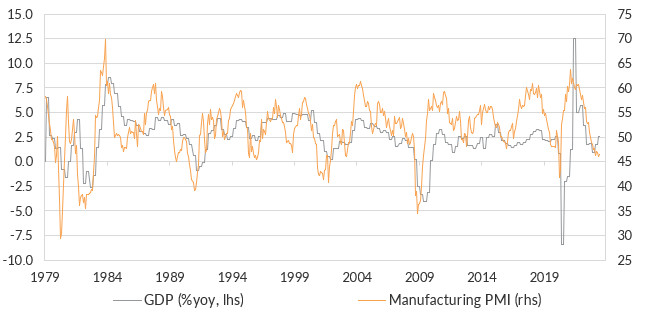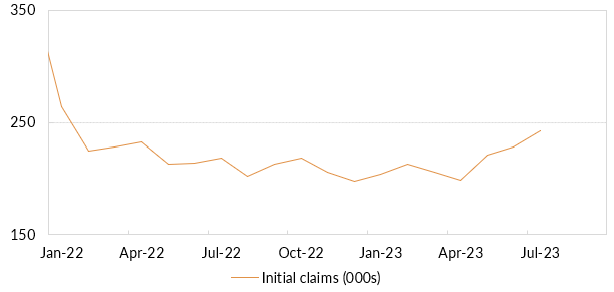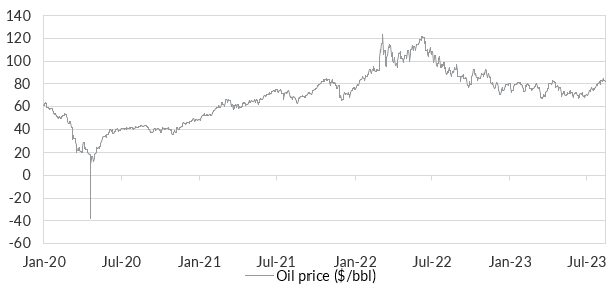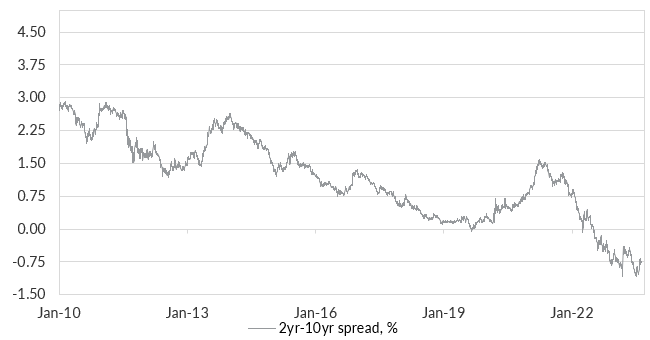How you can build portfolio resilience through options and bonds
Until recently, rampant tech and growth stocks had led US equities close to cyclical peaks. The economy had proven resilient – or at least unemployment has remained contained – and inflation has slowed. In July the narrow US rally broadened out, tempting investors to chase higher valuations amid multiple expansion. We think now is not the time to chase a rally. Now is the time to build resilience. Even if there is an opportunity cost.
The economy is slowing, but not in recession.
We have been following four key indicators to gauge the pathway of the economy. These include the manufacturing PMI, initial jobless claims, the oil price, and the US Treasury yield curve. The indicators suggest growth is slowing and below trend, but not in recession yet.
The manufacturing index has slumped below 50, a level that indicates sub-trend economic growth. The indicator has a great track record over the past 50-plus years. But my focus is on the number 45. Historically when the index has fallen below 45, recession follows quickly.
Chart 1: The manufacturing PMI is close to levels consistent with recession.

Initial jobless claims have been trending higher but remain volatile. The trend higher from the trough in late-2022 suggests the labour market is cooling, albeit modestly. This is a useful weekly indicator that could be consistent with recession if initial claims increase to around 300k from the current level around 250k.
Chart 2: Initial jobless claims are trending higher.

Oil prices have trended higher recently but remain contained within a range that has persisted since late 2022. This range has defied production cuts announced through this year. I have been gauging this market to get a sense of underlying demand. After moving to the top of the range, oil prices have recently drifted lower, countering forecasts for a breakout in prices. That suggests global demand is slowing, offsetting reduced supply.
Chart 3: Oil prices remain in a range despite production cuts.

The yield curve has steepened recently. Initially this was bear-steepening, led by longer-dated yields selling off. More recently there has been an element of bull steepening, led by a rally at the short-end of the curve. While curve inversion tends to get lots of focus as a harbinger of recession, our focus is on curve normalisation. Normalisation led by a rally at the front-end of the curve historically precedes recession as the market realises policy is too restrictive for the economy. We are not there yet, but the market is moving in that direction.
Chart 4: The yield curve has started normalising again.

Why should I build resilience?
We think the US economic expansion is looking long in the tooth. Things look good in the rear-view mirror. The unemployment rate remains low. Households are spending. But there are worrying signs, looking forward. Policy rates are restrictive. Growth is slowing. Inflation is slowing. The manufacturing sector is slowing. We think the environment calls for caution, even if there is an opportunity cost for investors.
Risk is skewed to the downside for the economy and for risk assets. That includes equities and corporate debt, especially high yield. A recession or downturn should see equities slump. The decline could be particularly painful given the elevated starting valuations.
There is a risk that the economy reaccelerates, inflation stabilises, and investors enjoy a goldilocks scenario. Just because it hasn’t happened before, doesn’t mean it can’t happen now. And building resilience would mean giving up some of any potential upside. There is an opportunity cost. But we think that is worth paying now.
How can I build resilience?
There are many ways to build resilience in a portfolio. Enhancing diversification is a good start. With equity returns concentrated in a narrow sector, that could involve adding some quality or value to the portfolio. It may involve selectively adding alternatives with low correlations to traditional assets.
For some clients, protection may be added through an options strategy. The cost of these strategies can be seen as an insurance premium against a material drawdown in equities. This could be a cost-effective strategy for investors with the sophistication and ability to implement such a strategy – either directly or through a fund structure.
For other clients, adding government bonds at yield levels that are high relative to recent and medium-term history is an option. We observe shorter-dated government bond yields offer attractive risk-return characteristics, under a range of forward-looking scenarios. Longer-dated Treasuries also offer downside protection, but the return profile is less favourable if yields continue to edge higher.
When should I build resilience?
We think the right time to build resilience is now. Trying to time the markets or wait until recession begins risks asset prices gapping and wiping value from a portfolio. Yes, there is an opportunity cost to resilience. But we think the growing economic risks make the potential benefits of resilience more than worth that cost.
5 topics

